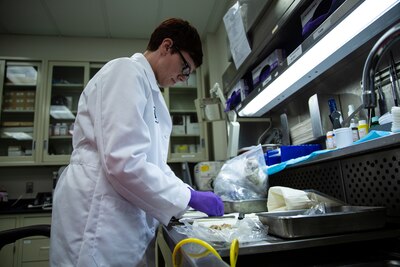
SILVER SPRING, Md. —
During patient rounds at the Defense Department’s Joint Pathology Center here, veterinarians taking part in the Veterinary Pathology Residency Program examine slides of canine tissue on a multiheaded microscope. They agree on the diagnosis of a lymphoma — cancer — in a military working dog, as the director of the veterinary pathology residency program encourages their observations and conclusions.
“We see not just military working dog [cases], but also U.S. Capitol police dogs, Border Protection dogs and Secret Service dogs,” among other federal canine pathology cases, said the center’s director of veterinary pathology, Army Col. (Dr.) Derron A. Alves, a veterinarian. Additionally, he said, the service sees pathology samples from the animals of active-duty service members.
Veterinary pathologists do not see live animals. The staff and residents of the program see tissue and organs from animals submitted by any of about 500 Army veterinarians.
For example, if an Army veterinarian surgically removes a mass from a dog and sends it to the lab for a diagnosis, it will be examined by pathologists at the center. “Every tumor that comes in gets four or five sets of eyes on it,” Alves said.
Veterinary Pathology Defined
The Joint Pathology Center doctors — five staff members and 10 Army residents — are veterinary pathologists, meaning they are board-certified as both veterinarians and pathologists, who consult and diagnose diseases in animals. The team sees about 3,600 cases a year, or about 300 a month, Alves said. The Army residency program for training in veterinary pathology is the only one of its kind in DOD, he emphasized.
Once the residents graduate from Alves’ program and become board certified in pathology, they are sent around the world and to research institutions such as the Walter Reed Army Institute of Research here and the Army Medical Research Institute of Chemical Defense at Aberdeen Proving Ground, Maryland. Veterinary pathologists total about 54 military officers worldwide, he said.
Since the 1940s, DOD has considered veterinary pathology interlinked with human health and environmental issues such as anthrax, Ebola and the West Nile virus, said Alves, who also is the veterinary pathology consultant to the Army surgeon general.
One-Health Approach
The relationship among animals, humans and environmental issues comprises what the colonel calls the “One Health” approach. Specifically, he explained, certain animal species can mimic the same disease as in a human. Studies using animal models also include research on traumatic brain injury and on chemical or thermal burns to see how such issues affect the human body, he said.
“Animal models and animal studies … are extremely important, because we cannot use human patients in some studies,” Alves said, using anthrax and Ebola as examples. “Oftentimes, we have to develop an animal model that mimics that disease in humans to study … how a disease manifests and becomes clinical,” he explained.
Animals given particular agents are then examined post-mortem to see why and how the disease might affect human tissues and organs, Alves said. “But more importantly, we’re trying to develop countermeasures or medical treatments against those potentially harmful diseases,” he added.
Blood Loss Studies
Battlefield injuries are an example of how animal studies contribute to human health.
“There’s often a period of time when a service member is injured on a battlefield and getting him to a medical treatment facility to stop the bleeding is extremely important and relevant,” Alves said. “If we can use animal models to support decreasing that time, it’s very important.”
Likewise, about 60 percent of animal-borne diseases are transmittable to humans, he noted.
The plague is an example of the important relationship among animals, humans and the environment, Alves said. The disease is endemic in the rodent population of the Four Corners region of the United States, where Colorado, Arizona, Utah and New Mexico meet. “If we see a spike in humans with the plague, it becomes a human health, animal health and environmental concern,” he emphasized.
“Veterinary pathology is just like human pathology. Skin is skin, a heart is a heart, a liver is a liver. There may be some differences in species, but ultimately the tissue looks very similar,” Alves said. “Once we get over that hurdle, veterinary pathology is essentially the same thing as human pathology. We just do it with four legs.”



